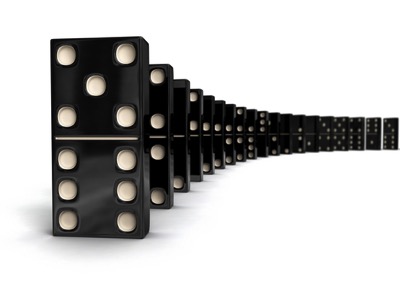Dancing with the Dominos

Since it’s Throwback Thursday, here’s a Grasshopper tidbit from years ago:
“Small Adjustments Start Big Changes” – Grasshopper
“Our routines run us” is the foundation of what I believe, and when our routines don’t serve us well, we opt for wholesale change. That practice rarely works, and if it does, it’s often short lived.
Starting with too big a piece is what I refer to as “eating a whole cow at once.”
I’m saying more than “start with baby steps” here; I’m advocating for adjustment rather than preaching lock, stock and barrel change.
Let’s pretend that you have no rhythm and are a lousy dancer. You set out to change that. You take your two left feet and head to the Johnny Castle Dance Studio. I don’t care how many dance lessons you take you’re not going to wind up on “Dancing With The Stars.”
Your wholesale change strategy is to be a top dancer rather than enjoying dancing. If you are just focused on change, you miss the fun dance steps that can take you there. That’s where adjustment comes in. Change needs a new angle of view.
We get boxed into one way of seeing things and we think the only way to get out of our predicament is to make a major change – to be someone different than who we are. That desire causes us untold pain. We don’t want to work with who we already are, but want totally to be someone else.
When you go for wholesale change, it’s like being in the witness protection program. You are forever looking over your shoulder at the person you really are while pretending to be someone else. It causes lots of strain.
We rarely shift our position a few degrees and take another look. That’s adjustment.
Adjustment is taking time to look at you from another angle of view. Doing so is the catalyst for big changes.
You don’t need to change who you are; you just have to adjust what you do. Your routines are what need to be adjusted, not you. You’re fine; it’s your behavior that keeps you stuck.
Here’s the best news: You don’t have to adjust the behavior you want to work on; you can adjust any automatic behavior you have and it will have a domino effect.
Just start noticing things you automatically do and slightly adjust that behavior. Then notice something else that you automatically do and adjust that too. What you are training yourself to do is to notice your automatic pilot approach and making slight adjustments. You are looking at you from a different point of view – as an outside observer.
When you notice any routine that you run and make an adjustment, you are making an adjustment to your whole automatic system. After some practice, you’ll start to notice other things changing, slowly at first, and eventually they’ll reach a tipping point.
The key is to start noticing any automatic behavior and then adjust the routine slightly. Adjust every time you notice and before too long, you’ll notice changes happening everywhere.
It could be as simple as noticing that you say, “God bless you” when someone sneezes. Make a small adjustment and say something else or nothing at all.
Routines hold our behavior together. Looking at these routines from another angle (as that of the observer) and then making a slight adjustment causes these routines to come apart over time, making room for change.
It’s a highly effective and indirect method of going after change that’s different and much gentler than the way we pursue change now.
When you observe your behaviors from another angle of view and adjust what you do, you make change about the behaviors and not about you. That’s when big changes happen.
All the best,
John
Be Sociable, Share!
